|
FAQs about Marine Snail Egg
Identification
2
Related Articles: Gastropods, Sea Slugs, Mollusks, Abalone,
Related FAQs: Snail Egg
ID 1, Snail Egg ID 3, &
Snail ID 1, Snail ID 2, Snail
ID 3, Snail ID 4, Snail ID 5, Snail
ID 6, Snail ID 7, Snail ID 8, Snail ID
9, Snail ID 10, Snail ID 11, Snail ID
12, Snail ID 13, Snail ID 14, Snail
ID 15, Snail ID 16, Snail ID 17, Snail ID
18, Snail ID 19, Snail ID 20, Snail
ID 21, Snail ID 22, Snail ID 23, & Marine Snails 1, Marine Snails 2, Marine Snails 3, Invertebrate ID, Snail Behavior, Snail Selection, Snail Compatibility, Snail Systems, Snail Feeding, Snail Disease, Snail Reproduction, Mollusks, Sea
Slugs, Abalone,
|
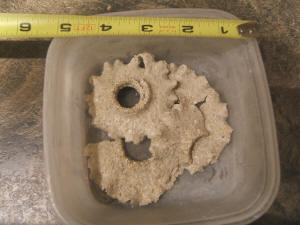
|
Unidentified Egg Casings? (and the unknown worm) – 5/26/12
Hello, I hope you are doing well.
<Thanks Rhi, and back at you. How may I help you today?>
I got up this morning to find 9 transparent "things" sticking out of the
sand bed and I hope you can assist in their identification.
<I’ll certainly try.>
They appear to be shell casings
<Definitely egg capsules/casings of some sort.>
…from something, my question is, what?
<That’s a good question. What snail species do you currently have in
stock?>
They are approximately an inch to an inch and a quarter in height
<That’s a sizeable capsule.>
…and appear to have a base made of sand. A photo of dubious quality is
included.
<It looks good to me, thanks.>
I have a good deal of diversity in my reef tank, including many species
of snails and some odd creatures I sent pictures of before. Sadly we
weren't able to identify those
<Yep, I remember those and despite further research, I still don’t know
what they are. Unsolved ID’s like that really prey on my mind
until solved.>
..and upon advice I tried to remove one that was irritating a Duncan
colony with tweezers and all the "fluffy parts" at its base flew off and
are now populating multiple areas of rock around the tank and irritating
various other corals at night.
<Oh no, I’m so sorry! That’s the downside of not knowing what sort
of creature we’re dealing with.>
Since those appear to reproduce via some kind of cloning at the base I
don't suppose the eggs belong to the unidentified worm-thing.
<Nope, I would seriously doubt it.>
However, I will include a photo of it with its "babies" that I took once
the worm was removed, just for curiosity's sake. I really would love to
know what they are.
<You and me both! I’m going to do some more research, ask some
people and see what I can find. It may take awhile, but if/when I get an
answer, I’ll be sure to let you know.>
Thanks for your time,
<You’re very welcome. Do let me know what snail species you
currently have and we’ll figure out which one left those capsules.>
Rhi
<Take care, Lynn Z>
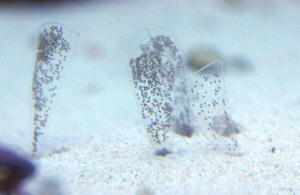
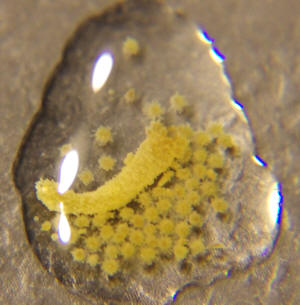 |
|
Re: Unidentified Egg Casings? (and the
unknown worm): Possible Babylonia Egg Capsules - 5/27/12
<Hello Rhi>
As you know, vendors of aquatic life are not the most accurate when it
comes to labeling their "merchandise"
<Yes, unfortunately it’s not a priority for some. It puts the onus
on the consumer to beware and research before bringing any organism(s)
home.>
… and I acquired my CUC from various places, but I will do my best to
identify what I have in the tank now.
<Thanks, I appreciate it.>
Astrea snails (Astraea tecta)
<This has been reclassified as Lithopoma tectum but the old species
name, Astraea tecta, is still widely used. This is a broadcast
spawner (eggs and sperm released into the water column), so it’s out of
the running as far as producing egg capsules.>
Large Cerith snails (Cerithium sp.)
<Reproduction can vary with these but we can rule them out as well. Most
that we see in the hobby leave either clear to translucent meandering
ribbons dotted with eggs, or whitish, rope-like “snail trails” adhered
to hard surfaces or sometimes anchored to, and strung across, seagrasses
or macroalgae.>
Margarita snails (Margarites pupillus)
<These are broadcast spawners, so no capsules. They’re also a
cooler-water species that doesn’t last long when exposed to the higher
temperatures of reef systems.>
…tiny Nassarius snails (Nassarius sp.) - based on shell coloration there
appears to be multiple types here
<Nope, no capsules here either. They tend to deposit eggs in
swaths and “trails” on hard surfaces.>
36 Caribbean Nerite snails (Nerita sp.)
<Nerites do produce capsules deposited in loose groupings, but they're
typically low profile, white to cream-colored, and round to oval in
shape.>
Stomatella varia
<These are broadcast spawners, so no capsules.>
2 huge "Orange spot Nassarius snails" (Babylonia formosae?) which now
after looking up their scientific name am concerned are actually
carnivorous whelks that killed rather than "cleaned up" my baby maxima
clam that died recently. (The tank was laying fallow and so was being
fed lightly due to dearth of fish)
<Yikes, yep Babylonia snails and bivalves are not a good combo – at
least as far as the bivalves are concerned! This species does
however leave egg capsules that are typically adhered to a hard
substrate. Unfortunately I can’t find any photos for comparison.>
a couple of Turbo snails (Turbo fluctuosa)
<Turbo’s typically either broadcast spawn or release an egg mass,
sometimes adhered to a surface, sometimes loose.>
The eggs are still present and unchanged in the tank and I look forward
to hearing from you.
<Well, by process of elimination, the most likely candidate is the
Babylonia snail. It also makes sense because of the size (big
snail - big capsules) but I’d feel a whole lot more confident if I could
find a photo for confirmation. If they are indeed from this snail,
the young should begin to emerge after about 5 days and enter into a
planktonic larval (”veliger”) stage that lasts around 8 - 10 days.
Unfortunately, the fact that they do go through a free-swimming phase
limits their chance of survival as they are exposed to all manner of
threat, from livestock as well as equipment.>
Thanks again for your time.
<You’re very welcome. Again, I’ll let you know if/when I’m able to give
you an answer regarding the other worm-like critters.>
Rhi
<Take care, Lynn Z>
|
Keyhole Limpets and Other
Snails, repro., comp. -- 3/10/11
Hi Crew,
<Hello Sam, Lynn here today.>
I have a 24 gallon Aquapod. Among my critters is a pair of Keyhole
limpets that I bought about 2 years ago. I now have a few dozen babies
and am curious as to how they manage to reproduce.
<It varies, but typically they broadcast gametes (sperm and eggs)
into the water column. Interestingly enough, some actually brood their
young.>
I seem to find the babies in the most unlikely places like in my hang
on skimmer.
<Yep, I can tell you from personal experience that they also like
hang-on filters! Judging from the fact that these limpets reproduce
successfully in home aquaria, they more than likely have a very short
free-swimming larval stage. Many likely perish during this period due
to equipment issues and predation. However, the lucky ones find
sanctuary in the relative safe haven of skimmers, filters, fuges, and
the like. There, they find an environment with sufficient food to
entice them to settle and metamorphose into tiny replicas of their
parents.>
They grow very slowly.
<Yes, they do -- or at least mine seemed to.>
My first set of babies are still about half the size of a split pea.
Aside from the fact that they are very difficult to remove as compared
to the average snail
<Heee! Hence the term 'clings like a limpet'!>
..they seem to be good algae eaters. For some reason one of the adults
does bother one Blastomussa wellsi that I have.
<Funny you should mention that. I had the same experience with one
of the limpets I had. I caught it munching on my favorite B. wellsi one
morning and promptly banished it to the fuge!>
It almost destroyed it 3 times already but each time it recovered.
<That's the great thing about Blastomussa wellsi, in good
conditions even a polyp that's been reduced to a near speck can
regenerate itself.>
I now keep the Blasto on my crushed coral figuring the limpet will not
like to pass over that and since then it has not harmed it.
<Good thinking>
I also have a few Strombus snails, the kind that lay these little round
see thru packets of eggs.
<Are they the snails typically referred to as 'Strombus
Grazers'? If so, they're more than likely Columbellids, aka
'Dove Snails'. They're wonderful little grazers that
reproduce like rabbits. Please see the following link for more
information and photos for comparison: http://bb.wetwebmedia.com/viewtopic.php?f=25&t=341
>
I used to have 6 adults but now have 2 plus 3 small ones. I still see
many egg packets but it seems that very few make it.
<Something may be preying on them or perhaps there's just not
enough food to go around.>
These things seem to go in cycles. I used to have hundreds of
Stomatella snails and now am down to a few here and there.
<Don't you just love these little snails? Sadly, other critters
love to pick at, and eat them, particularly peppermint shrimps.>
Just sharing,
<Thank you for your terrific observations!>
Sam
<Take care, Lynn Z>
|
White Spots: Possible Nerite Egg Capsules --
3/9/11
Hello,
<Hello there, Lynn here this evening.>
Our tank has been up and going for around 7 months. In the last
48 hours or less these white dots have appeared on my live rock.
I have done several searches for them and asked the question on a
couple of forums before bringing it to you guys. It started as 5
spots that I noticed on one rock. Last night I noticed a group of
ten of them one the same rock. This afternoon I found say 50+ of
them all over the tank. The tank is 180 gallon and I have these
peppered all of the way across. I am at a total loss for what it
might be. All of my water parameters are within normal limits. I
enclosed a picture with some of the spots circled to help with
the ID.
<By any chance do you keep Nerite snails? If so, then those
are more than likely egg capsules. Nerites typically deposit
loose groupings of oval to round, white to cream colored capsules
on hard surfaces, and are often compared to sesame seeds. Each
capsule contains a number of eggs that soon hatch into
free-swimming larvae with, unfortunately, very little chance of
survival. For more information and photos for comparison, please
see the related FAQ's at this link:
http://www.wetwebmedia.com/SnailEggIDF1.htm?h=
More info here: http://www.advancedaquarist.com/2003/9/inverts
>
Again thanks again so much guys this will be a great help to
us.
<You're very welcome! By the way, if you don't have
any resident Nerites, let me/us know what other snails you do
have and we'll take it from there. Also, if you could get a
close-up shot of one of the spots, that would be great! Take
care, Lynn Z>
|
|
[1]%20reef%20tk%20bugs.jpg) [1]%20crop.jpg)
|
|
FOWLR test kit ?? 1/20/11
Hi there, hoping for an amazing day to you!!
<Hello Ingrid. Just waking up is amazing.>
I wanted to know from your advance-expert aquarist point of view,
what is the best or top 3 precise-accurate Test Kits for a FOWLR
salt water system.
<Well if you want the best, the LaMotte Test Kits would be my
first choice, but rather pricey. Next to that, I like
Salifert's kits followed by Seachem.>
And my 2nd question that has nothing to do with the last, I read
your articles about Nudibranch eggs and I'm attaching 2
pictures that appear to be eggs, I just want to be sure
they're eggs and my Nudibranch
are 2 Pacific Lettuce Slug (Tridachia crispate), and both left
eggs.
<Pics are not resolved enough to even take a stab at it. Most
point and shoot digital cameras have a macro feature on them
usually indicated by a flower symbol. If you have one, try taking
a few picks with that and our residential expert on the
subject
(Lynn) can help you out.>
Thank You Very Much !
<You're welcome. James (Salty Dog)>
Ingrid Leija
Follow-up Re: FOWLR Test Kit, Now: Sacoglossan Sea Slug
Egg Ribbon -- 1/20/11
Hi again, James
<Hello Ingrid, Lynn here this evening on behalf of my good
friend, James.>
I'm adding the pictures again; hopefully you can see it
better and give me your opinion.
<Thank you! What I see in the photos is definitely in keeping
with egg ribbons from the various 'Lettuce Sea Slugs'
generally seen in the hobby. I'm not sure which species you
have, but if your individuals were labeled as Pacific Lettuce Sea
Slugs, they could actually be Elysia diomedea from the Eastern
Pacific instead of Elysia/Tridachia crispata (an
Atlantic/Caribbean species). It's not unusual for the two to
be confused. Please see the following link for more information
and photos (including egg ribbons) of Elysia diomedea: http://www.seaslugforum.net/showall/elysdiom
Elysia/Tridachia crispata information/photos: http://www.seaslugforum.net/showall/elyscris
Hope that helps!>
Thank you
<You're very welcome.>
Ingrid Leija
<Take care, Lynn Zurik>
|
 |
|
Fish Compatibility Question Actually'¦ And
Conch Eggs Too? -- 04/16/10
Eric!
<<Chris!!>>
It's Chris K again
<<Indeed it is! [grin]>>
(I've tried to stay away, but I usually show up again like a
bad penny).
<<Ah'¦no worries my friend>>
I felt like I won the lottery last time we spoke regarding the
blue assessor and possibly being able to add it to my aquarium
with my other fish.
<<Mmm yes, I remember>>
Just to refresh you
<<Thank you for this>>
I have a 90 gallon, with 20 gallon sump and refugium, 4 clowns (2
ocellaris and 2 black and white Percs), 1 yellow tang, 1 flame
angel, 1 Sixline wrasse, 1 Firefish goby and 2 very small neon
gobies (and a few small corals).
<<Ah yes'¦>>
I have discovered another blue fish and I would like to ask you
about its compatibility.
<<Okay>>
It is an ORA tank raised Indigo Dottyback.
<<Mmm'¦>>
I stumbled across it today - it's gorgeous!
<<Indeed>>
From what I am gathering I am afraid of two things - either
it's going to be too mild of a fish to add at this point
considering what I already have in the tank,
<<Always a possibility'¦ Like with the Assessor,
it's my opinion the Sixline will be the biggest problem re
compatibility issues, with the Flame a possible
'short-term' antagonist. And also like with the Assessor,
removing these two for a week or so while the newcomer settles in
can help 'though you may see a reversal of the
situation with the Pseudochromis and the Wrasse upon
reintroduction (it may be classed as 'mild mannered' as
Dottybacks go 'but it is still a
Dottyback)>>
OR, it will be best to keep it in a small group which may cause
me to be overstocked.
<<While a group of these in a 'species specific'
display would be stunning 'I certainly don't think
there would be a problem with keeping a single specimen with a
mixed group of fishes>>
What do you think?
<<I think I just told you'¦[grin]>>
Could it be better than a 50% chance?
<<It could well be a better 'risk' here than the
Assessor, yes>>
Hoping for a great big "eureka" here....
<<Do I hear singing?>>
Also - I recently (2-3 weeks ago) purchased a conch - There was
confusion as to whether it was a fighting conch or a queen
conch
<<Hmm'¦a BIG difference,
ultimately 'and either one arguably too big for a
90g>>
- however they charged me for a queen conch
<<But of course they did'¦>>
- .... regardless, lately it has been sitting on a certain rock
and I believe laying eggs (I have attached a photo if you are
able to confirm).
<<Yep, these are egg casings>>
If they are eggs, do they need a male to fertilize them
<<Yes>>
or is it possible that she was "pregnant" when I
purchased her.
<<Considering the newness of the acquisition, this is
likely the case here>>
Is there a chance that these could actually hatch?
<<Sure 'but don't get too excited. The
larvae will be tiny (microscopic even) and
planktonic 'I think it very, very unlikely any would
survive the month or so in your display that it takes before they
would settle out 'and even then they would likely fall
prey to the Wrasse (and maybe Pseudochromis?) in short
order>>
I am really not sure what to expect.
<<I would not 'expect' anything much
here>>
Or if there is anything I should do to aid in their survival.
<<Unless you have the resources and equipment, and are
prepared to institute a Conch breeding program, there's
nothing 'to' do>>
Thanks again so much!!
<<Always a pleasure>>
And P.S. I am always inclined to follow up and let you know how
things work out!
<<Most excellent'¦ Be chatting! Eric
Russell>>
|
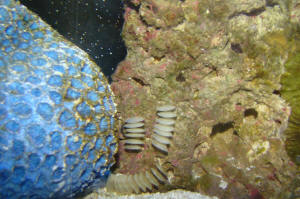 |
|
Re: Fish Compatibility Question
Actually 'And Conch Eggs Too? Conch & Cuke sel. -
04/17/10
Eric!
<<Chris!>>
Yes! You hear singing - fortunately (for everyone else) there are
no mountains near me or I would be singing from the top of
them!
<<Hee-hee!>>
I wonder though... Why did no one at my second favorite LFS
indicate that the conch I was so interested in would be too big
for my aquarium?
<<Mmm well, can't say for sure not knowing them,
but'¦ As for the conch, Strombus alatus needs a 100g+
system with more sand (4' deep or more) than rock for a happy
lifetime'¦Strombus gigas will need likely three times
this volume>>
Actually that's a rhetorical question - I realize that they
want my 20 bucks.
<<Ah!>>
-I read that conches can lay up to half a million eggs at a time
- but it sounds like I am not going to be making my first million
by selling baby conches for $2 a piece at the next frag swap (big
sigh) :)
<<Yeah, I used to think I could finance my hobby by selling
SPS frags locally 'if it were only that easy,
eh?>>
Fortunately, I can take the bad news with the good - eventually I
will need to get rid of the conch, so I am not planning on
getting too attached. I was merely looking for something to keep
my substrate nice and clean. I have gotten past touching crabs,
snails, conches, shrimp... but I am not sure I am ready to handle
the creepiness factor of a sea cucumber,
<<Some are actually quite good sand
sifters/detritivores'¦but don't expect one to keep
your substrate all 'clean and white'>>
and the dreaded "Cuke nuke" frightens me.
<<The more commonly available sand-sifting species (e.g. --
Holothuria hilla or Tiger Tail Sea Cucumber and Holothuria
floridiana or Common Atlantic Sea Cucumber) pose only a small
hazard re, in my opinion. I have kept these since the late
eighties without incident>>
(In case I am being too subtle, (ha-ha) I am fishing for
suggestions here - if you are so inclined,
<<One of the above mentioned Cukes, with some Nassarius and
Cerith snails, and a Brittle Star>>
do feel free to tell me that "Cuke nukes" are over
rated)
<<The potential is always there 'but I have even
heard 'speculation' that in a captive system the toxicity
of these creatures may even decline over time. At any rate, if
the animal is not being 'attacked,' I think you have
small reason for concern with the species mentioned>>
But on the bright side my Sixline wrasse is going to be fat and
happy for a while and.... I think I am going to be getting a
beautiful blue fish to complete my palette, which if memory
serves, brings me to exactly what I was looking for to begin
with! TA DAH!
<<Now how does that saying go'¦oh
yeah'¦'Yes, Virginia [Chris!], there is a Santa
Claus''¦>>
I plan to follow up with you to let you know how things go
<<Great!>>
- your wisdom has been invaluable and your patience with my
unrelenting droning over a blue fish have been positively
inexhaustible.
<<Has been my pleasure>>
I am expecting a good result - and I would like to be able to let
you know that your efforts were not wasted!
<<If only one person ever reads/benefits
from 'it is never wasted. Not to mention the
opportunities provided to expand my own horizons>>
Thanks again - as always!
Chris K
<<Be chatting my friend! Eric Russell>>
|
|
Wendletrap OK with Lettered Olive Snails?
With Caution - 4/13/10
<Hello, Lynn here today.>
I brought home some tiny (1/2 inch) Wendletrap (Epitonium
humphreysii) shells
<These are beautiful snails but not recommended for systems
with corals and/or anemones.>
..from the beach (TX gulf coast)
<Oh, lucky you. That's one of my favorite places to
vacation.>
..today in a plastic container. There was a tiny bit of water in
the bottom from washing them off.
<Uh-oh, I know where this is going.>
They were washed up dry with some debris on the beach
<Heeee! Is it seaweed season already?>
..so I mistakenly assumed they were empty or dead. I was wrong.
There are a few that are still alive. Lucky me, right? The beach
is a 90 min drive from here so returning them isn't an
option. I want to know if it would be a mistake to introduce them
in my tank.
<Well, there's always the possibility of adding some sort
of 'uninvited' guest (pathogen, parasite, pollutant,
etc.) to the system. Just how big a risk that is, I'm not
sure. Bob, any thoughts on this? One thing I'd like to add is
that Epitonium species apparently secrete a purple substance that
has been listed as a toxin and/or anesthetizing agent.
Unfortunately, I don't know how much/if any risk this
presents to your livestock. If it's a toxin, the more water
volume, the better (for dilution). Running carbon is also a good
idea as a preventive measure.>
The shells are very beautiful
<They are indeed.>
..but I don't want to hurt my current residents.
<I can certainly understand that.>
I have a rather unique tank in that everything was collected in
the wild. My tank is about a year old and running fine. The
substrate is 2-3 inches of sand.
<If it's fine-grained, it would be better to have either
3' or more for a DSB or less than ½' to
1' for a shallow bed.>
There's not much in there, but everything is predatory. I
have a Sergeant Major Damsel that is a year old, (very
feisty)
<Oh yeah.>
..some kind of striped Killifish who is rather tiny and boring
but he's a super cleaner, and about 5 Lettered Olive Snails.
I have read that LOS's aren't good in a tank
<Just depends on what kind of tank you want.>
..but in my setup they're terrific!
<There you go!>
They're super efficient sand sifters and I've got nothing
in the tank for them to harm. I feed them defrosted chopped salad
shrimp about once a week and sometimes they get a treat of
scallops which brings them all up out of the sand simultaneously.
Watching them eat is really entertaining.
<I bet it is!>
They're even laying eggs lately, but that's another
story...
<I'd love to know more.>
Once in a while the SM fish will peck at their snorkels
(that's what I call them),
<That's an apt description. It's called a siphon, a
structure common to predatory and/or scavenging snails that's
used for respiration as well as food detection. As water is
inhaled, it passes by chemoreceptors that allow the snail to
'taste' it for any signs of food.>
but they're not hurt by it.
<Good>
Given what's in the tank, would the Wendletraps attack the
LOS's?
<I doubt it. Wendletraps/Epitonium spp. feed on corals and
anemones, including Aiptasia and Heteractis malu (depending on
the snail specie). Also, some species don't actually feed on
the tissue, but instead consume the mucus.>
If the LOS's would attack the Wendletraps I don't think I
would mind too much. Just more food for them.
<It's possible that they may well go after the
Wendletraps, especially if they're hungry/aggressive
enough.>
Also, I couldn't find anything on this site or the web about
whether they would be on top or underneath the sand.
<They'd be on top.>
And if they'd climb the glass and whether they'd be OK in
the air and trying to get out. I have cats. I don't want to
find Wendletraps in my bed one morning. :-)
<Heeeee! You should be fine. Wendletraps sometimes end up on
the beach as a result of a storm, or unusually high tide, but
that's about it. The same cannot be said for Nerites though.
If you decide at some point to try some of these, beware. I can
tell you from personal experience that they have an unfortunate
tendency to go on 'walkabout' and end up as cat
toys!>
Thanks for your advice and the great site!
<You're very welcome and thank you!>
The search feature isn't working for me, not sure why,
<Oops, sorry about that. I just checked and it seems okay but
do let us know if you continue having problems.>
..but I skimmed all the snail pages looking for anything on
Wendletraps and couldn't find anything. Plus I doubt
there's another person with LOS's!
<There have been a few, but we mostly discourage them for
mixed reef systems because of their predatory nature and possible
threat to beneficial DSB fauna.>
Thanks!
<You're welcome! Take care, Lynn Z>
Re: Wendletrap OK with Lettered Olive Snails? With
Caution. Also, Info re: Olive Snail Reproduction -
4/14/10
Hi Lynn,
<<Hi Amy>>
Thanks so much for your reply and information.
<<You're very welcome.>>
<Is it seaweed season already?>
Not yet. Although some kind of vegetation is washing up here and
there. It's little 1 inch brown segments. I'm finding
them in 6 foot wide patterns, as if a plant has disintegrated its
pieces washed up.
<<Yep>>
What's mostly washing up right now though are jellies.
<<Yuck>>
I was there (Surfside Beach, TX, south of Galveston), a couple
weeks ago and there were tons of cannonball jellies.
<<It's amazing now numerous they can be at
times.>>
Yesterday some of those were still there, but now the man o'
wars are coming in.
<<Yikes>>
Peak season for the Sargassum seaweed is later in the summer
months.
<<It seems like that's what I remember from being a kid
but for some reason, the last few times we've been to Port
Aransas in early May, it's been all over the
place.>>
That's when we find some really cool specimens of marine life
to look at!
<<Oh, definitely!>>
Funny how much life people walk right over on the beach and never
even know it's there!
<<Absolutely!>>
We've found crabs, shrimp, Nudibranchs, anemones, and below
the floating clumps of it, before it beaches itself, are
beautiful juvenile trigger fish, tons of juvenile Sergeant
Majors, and even Sargassum Fish!
<<Neat! Sometimes you can find the little floating purple
Janthina sp. snails that eat Man-O'-Wars tangled in there as
well, or the lightweight little Spirula spp./'Ram's
Horn' snails.>>
We found several other species of fish I wouldn't want to
name because I don't know for certain that I identified them
properly. But it's like a floating reef!
<<Yep, those floating mats become little ecosystems with
all sorts of critters living within and around them.>>
Anyway... I'm rambling. It's a favorite subject of mine
and I could go on forever!
<<Sounds like we're two peas in a pod then!>>
<Epitonium species apparently secrete a purple substance that
has been listed as a toxin and/or anesthetizing agent.
Unfortunately, I don't know how much/if any risk this
presents to your livestock.>
I've seen a little bit of a reddish/purple tint on the tip
end of a few of the snails. If that's the volume of their
toxin capabilities it's minute, but thanks for the warning
and I'll keep a sharp eye out.
<<Yep, it's always best to be forewarned.>>
<Running carbon is also a good idea as a preventive
measure.>
Got that covered!
<<Good>>
<If it's fine-grained, it would be better to have either
3' or more for a DSB or less than ½' to
1' for a shallow bed.>
The Sergeant Major Fish will fan the bottom and make deep
depressions in one side, and a big pile on the other side, like
he's creating a hidey hole for himself. It's cute so I
quit trying to fix it. He's apparently more comfortable like
that. One side is 1" and the other is well over 3". My
sand does create bubbles so I read that's a good thing.
Re: my Lettered Olive Snails...
They're even laying eggs lately, but that's another
story...
<I'd love to know more.>
One night I went to the tank to feed the fish and turn the light
off for the evening, and there were tiny (1mm) translucent disks
everywhere, and millions of dots that I can't describe
because they were so small. It was like a heavy snowfall!
<<Wow!>>
My fish were chowing down! I took photos of it because I
didn't know if I'd ever see it again and at the time
didn't really know for sure what was happening.
<<I'm so glad you got photos! You did indeed witness a
spawn.>>
I looked it up on your site and read about it later. I never saw
anything on top of the sand, on the glass, but it could be that
they laid the eggs on top of the sand and either the SM fish
stirred them up, or the water flow from the filter output did
it.
<<Nope, the eggs actually do float. In the wild, they rise
to the surface and drift about on the current before hatching
into a free-swimming planktonic form called a
veliger.>>
Well, within a couple hours it was all over. Half eaten, half
sucked up in the filter. So I wanted to see if any would survive
so I left that filter in for as long as I could, and checked in
there with a flashlight, but no luck. So then about a month
later, it happened again. This time right before my eyes!
<<Neat!>>
I was staring at the tank, noticing that a couple snails were
interacting under the sand. I could see it actually undulating.
The thought crossed my mind that they were procreating... but I
thought nahhh... can't be. Sure enough, 5 minutes later one
comes to the surface and the little circles & dots erupted
into the water. There weren't as many that time, but it was
still a cool show.
<<Terrific observations!>>
The snail went right back under the sand so I didn't even get
to see from where in their anatomy they came from. This time I
have a brand new filter in there so I hope some will have time to
grow. We'll see. I think it would be neat to see one as a
baby.
<<It certainly would. From what I've read, they go
through a short veliger stage before settling to the substrate
and metamorphosing into crawling snails. What I'm unsure of
is whether the veliger stage is a feeding or non-feeding one. The
young stand a better chance if it's non-feeding.>>
In all the internet searches I've done, I have never seen a
baby Lettered Olive Snail.
<<Neither have I.>>
A couple of the ones I have are shorter than the others, about 1
inch, vs. the 2 inch older ones, but they're still adults
with many layers to their spiral shells. Is there any way to tell
how old they are?
<<Not that I know of.>>
<Wendletraps/Epitonium spp. feed on corals and anemones,
including Aiptasia and Heteractis malu (depending on the snail
specie). Also, some species don't actually feed on the
tissue, but instead consume the mucus.>
What would you recommend I feed them then?
<<The best thing would be what they eat in the wild, which
is most likely an anemone of some sort, but I don't know
which specie(s). If you perchance have any Aiptasia, I'd
watch for declining numbers. In lieu of that, I'd try various
meaty foods on hand.>>
I have some cubes of frozen sea urchin, but my fish won't eat
it
<<Can't say I blame them. I'm not a big fan
myself.>>
..and if it doesn't get consumed it dirties up the water and
then sits in the filter. So I don't want to experiment with
it if I don't have to.
<<I wouldn't, since it's so messy.>>
Also wondering if they would eat the shrimp that my LOS's
eat?
<<It never hurts to try. I'd offer a variety of foods
and see what happens. You might also want to try placing the food
up on the rocks (near the Wendletraps) so they won't get
overrun by the Olive snails in the sand. If the fish go after the
food on the rocks, you can try feeding at night
instead.>>
They'll die if they don't have something. Although
they're tiny so I don't know how long they'll go
between meals, do you?
<<I don't. Some organisms (various Cukes, stars,
anemones, etc.) can take a surprisingly long time to succumb to
starvation, but unfortunately, I just don't know how long it
would take for a snail.>>
So tonight after I got your response, I added them to the tank
and they've been in there for a few hours now. So far so
good! No LOS siphons. So they must not smell/taste like food
yet.
<<Yep. If/when one starts ailing though, they'll be on
it. Oliva sayana/Lettered Olive snails have no problem getting
through the shells of small clams so I doubt that a
Wendletrap's shell would pose much challenge. They're
usually pretty thin/lightweight.>>
My fish checked them out but don't seem too interested. The
SM did pluck one off the glass but he's ok. They look like
they have better footing on the oyster shells I have in there,
than in the sand. No traction in the sand I guess.
<<Likely so, yes.>>
I'll let you know if it's a success or if they become
food.
<<Please do.>>
Oh, one more question... about the LOS's digestion...
I've always been curious about what part of the anatomy this
is: When they come up for food, let's say a piece of shrimp,
they cover it with their body, head first, but then tuck it
underneath in this pouch kind of thing, and then go back down
into the sand with it dragging behind. Is that pouch just for
storage, or is it their stomach? It's hard to tell from
looking at diagrams.
<<It's actually the anterior portion of the foot called
the propodium. It's adapted for burrowing, propelling the
snail forward, and for trapping prey/food items. Once the snail
has the food trapped, it takes it back under the sand so that it
can eat at its leisure. Apparently this is accomplished thanks to
a radula (a many-toothed tongue-like organ) and the release of
fluids into the animal that break down the tissue.>>
Attached is a photo I took of the first LOS egg event where you
can see the translucent circles, and the dots, and one of the
LOS's eating a piece of shrimp.
<<I see them in the follow-up message, thanks!>>
Enjoy!
<<Thank you!>>
Amy
<<Take care, Lynn Z>>
Follow-up Re: Wendletrap OK with Lettered Olive Snails?
With Caution. Also, Info re: Olive Snail Reproduction -
4/14/10
<Hi Amy>
Oops, I forgot to attach the two photos mentioned in my previous
reply.
<No problem. Thanks for sending them along, they're
terrific! Take care, Lynn Z>
|
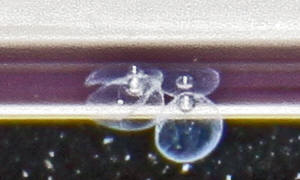 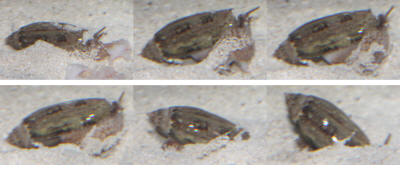 |
|
Something Growing on My Rock? Snail Egg Casings --
4/11/10
<Hello Bill, Lynn here today.>
I have a 90 gal salt tank 1 large lion-fish, 1 large eel (yellow
with black dots), 1 large black pointy sea urchin, 4 conch
snails,
<Do you know what variety/species?>
..many Mexican turbo snails, 1 brittle starfish, 1 chocolate
starfish, about 80lbs of rock, water tests good most of the
time.
<Need to aim for all of the time!>
I use a 1200 gph pump with overflow to sump containing miracle
mud and mangroves and a canister filter and turbo twist UV light
and a water chiller for temp with average 78 degrees. Can you
identify what these things are growing off my rock see
picture!
<Yep, they're snail egg casings, possibly left by a
Melongenid (Family Melongenidae), which includes species commonly
referred to as Conchs and Whelks. The casings you have are
definitely not from a Fighting Conch (Strombus alatus or Strombus
pugilis), or a Queen Conch (Lobatus/Strombus gigas), all of which
are in the Family Strombidae. Their egg masses resemble an
amorphous tangle of gelatinous string embedded with sand. Please
see the following links for examples:
Strombus alatus (aka the Florida Fighting Conch): http://www.jaxshells.org/1562anne.htm
Strombus pugilis (aka the West Indian Fighting Conch): http://www.jaxshells.org/1540anne.htm
Here's an example of a Melongenid's egg casings,
specifically Melongena corona (aka the Crown Conch). They're
a bit more rounded than the ones you have, but you can see the
similarity (and they do vary): http://www.jaxshells.org/mcegg3.htm
Here's another Melongenid example, the Channeled Whelk
(Busycotypus canaliculatus). Busycotypus/Busycon species'
casings are similar but usually have a bit more surface texture
(not as smooth): http://www.turtlejournal.com/?m=201002&paged=2
By the way, it looks like you have a nice little population of
beneficial Collonista snails, aka 'Mini-Turbos', roaming
the rocks! You can find more information on these at WWM. Just
enter Collonista in the Google search engine:
http://www.wetwebmedia.com/Googlesearch.htm >
Thanks Bill V
<You're very welcome. Take care, Lynn Zurik>
|
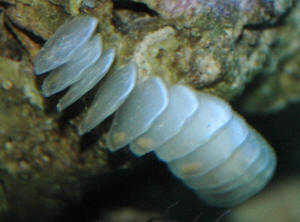 |
|
Re: Something Growing on My Rock? Snail Egg Casings --
4/12/10
<Hi Bill>
Thank You !!
<You're welcome! Lynn Z>
|
|
Unknown Thing Growing on Glass: Snail Egg Capsule --
3/14/10
Dear Crew,
<Hello Justin, Lynn here this evening.>
Can you guys help me out with what this is?
<Yes, it's a neat little egg capsule that looks very much
like those left by Nerite snails. They're typically white (or
whitish), oval to round in shape, around 3mm or so in length, and
deposited either singly or in groupings on hard surfaces.>
They look like eggs of some sort, but I have never seen anything
like it. They are quite small, a little larger than the end of a
ball point pen.
<Since you said 'they', I'm guessing that you mean
the individual eggs inside, not the capsule itself. If that's
the case, then it's consistent with Nerite
capsules/eggs.>
I tried my best with the macro lens, but this is the best I could
get.
<You did very well, thank you! For more information/photo,
please see the following link:
http://www.advancedaquarist.com/issues/sept2003/invert.htm
By the way, if you do not have any Nerite snails in residence, do
send along a list of what snails you have and we'll see if we
can't figure out who the culprit is!>
Thanks all
<You're very welcome.>
Justin
<Take care, LynnZ>
|
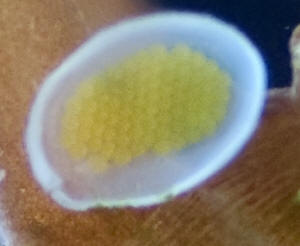 |
|
Re: Unknown Thing Growing on Glass:
Snail Egg Capsule, Nerite -- 3/14/10
Thanks LynnZ,
<It was a pleasure, Justin.>
Actually though the capsules themselves are only about the size
of the end of a ballpoint pen.
<That's pretty small but not beyond the realm of
possibility. The Nerite egg capsules commonly reported to us tend
to be larger, but they can vary according to species. For
example, Nerita tessellata (aka the Checkered Nerite) from
Florida reportedly has capsules that are only about 1mm in
length. Please see the following link for more
information/comparison:
http://www.sms.si.edu/irLspec/Nerita_tessel.htm >
I do have 3 Nerite snails left in the tank,
<I believe we have a winner!>
..some Trochus,
<It wouldn't be these snails. They're broadcast
spawners. That is, they release gametes (eggs/sperm) directly
into the water column (no egg capsules).>
..and I seem to have a breeding colony of Elephant snails as
well
<I'm guessing you don't mean the giant African land
snail (genus Achatina)! That's the problem with common names;
they're common as opposed to specific. Sorry to give you a
hard time but I just couldn't resist. I blame it on losing an
hour of sleep last night to the Daylight Savings Time switch. I
really need to move to Hawaii, where they don't mess with the
time twice a year! Anyway, back on topic, the terms 'Elephant
snail' and 'Elephant slug', are also used in
reference to Scutus spp. snails (black, slug-like snails in the
family Fissurellidae). If that's what you have, then we can
rule them out as well. Like the Trochus snails mentioned above,
they're spawners. See this link for more information/photos:
http://www.seaslugforum.net/showall/scutus >
..(I say this because every few weeks it seems as if I find
another small one (1/4" or so) crawling along the glass.
<Neat! Apparently, their survival rate in captivity is aided
by the fact that they go through a non-feeding, planktonic,
larval/'veliger' stage before metamorphosing into
crawlers. Non-feeding veligers tend to have shorter planktonic
stages than those that need to feed. The advantages are two-fold.
First of all, less time in the water column equates to less
chance of becoming food for fish, corals, etc., or perishing
within/as a result of pumps, filters, etc.. Also, the fact that
they don't need to feed gives them a distinct advantage over
those that require specific planktonic foods (that may not be
available in a captive system).>
It seems as I might have some pyramid snails attacking my other
snails though, since they have these tiny white conical shaped
snails hitching a ride, and starting to attach around the shell
opening by the foot.
<Hmmm, are the snails long, slender, and mobile, or
short/squat and sessile? If they're long, slender and mobile,
you're right, they're most likely 'Pyrams'
(family Pyramidellidae) and you'll need to get rid of them
(see WWM re: methods). The fact that they're gathered around
the foot/opening is typical of these pests. If the snails
you're seeing are short, squat and sessile, they could be
Hipponicids (aka 'Hoof snails'). These are roughly
conical, Limpet-like snails that begin life as mobile crawlers,
but eventually become sessile; attaching themselves to hard
surfaces (including snail shells). Luckily, they don't
actually prey on the snails they're attached to, but it's
possible that as they increase in size, they could inhibit the
snail's ability to move around and/or feed. Here's a link
with some terrific photos for comparison:
http://www.conchology.be/?t=65&family=HIPPONICIDAE
Hipponicid on a snail shell (see the FAQ titled 'Mollusk
Identification - Hipponicids 06/20/08'):
http://www.wetwebmedia.com/snailid16.htm >
What a pain it is to deal with that....darn pests!!
<Yes, indeed!>
Other than that, that would be it. Thanks again for the help, I
appreciate it.
<You're very welcome, please let me/us know if there's
anything else we can do for you.>
Justin
<Take care, LynnZ>
|
|
What Are These? Egg Capsules -- 11/29/09
Greetings to you at WWM!
<Woo-hoo and greetings to you too, Jamie! Lynn here this
afternoon.>
I tried to find this "thing" on WWM and did not have
much luck. What are these?
<Egg capsules.>
I've just emptied my tank of fishes due to ich and today I
saw these on my glass! Scary!
<Nah, they're neat!>
I tried to look for them at other places in the tank but these
are the only ones that I can see. I imagine that I wouldn't
be able to see them if they were on anything else but glass. I
guess in a way that I'm lucky that they are where they're
at! They look like some type of eggs or crustaceans, I hope
it's not another parasite!
<Nope, they look like snail egg capsules to me. By any chance,
do you have any Columbellids, aka dove snails in residence?
They're small, harmless/beneficial grazers of film algae,
etc., in the family Columbellidae. Please see the following link
for photos and more information:
http://bb.wetwebmedia.com/viewtopic.php?f=25&t=341 . By the
way, mine come out of the proverbial woodwork at night to graze
on the glass, so if you don't see any during the day, be sure
to take another look after the lights go out. If you don't
have any of these snails, please let me know what kind (if any)
you do have, along with the size of the individual capsules, and
we'll see if we can't solve this mystery.>
Do I need to do something to the DT to treat for these
things?
<Nope, let's see if we can't first figure out what
left these on the glass. Worse case scenario, if they're from
a snail you don't want, you can scrape the capsules off and
suction them out. After that, it's a matter of locating and
removing the snails.>
It's a 225 gallon reef tank sans fishes.
<Nice size>
I've enclosed a photo.
<Nice photo!>
Thanks So Much!
<You're very welcome!>
Jamie Barclay
<Take care, Lynn Zurik>
|
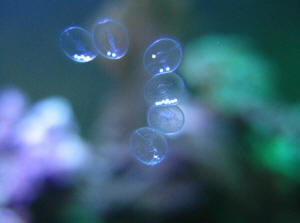 |
Re: What Are These? Egg Capsules --
11/29/09
<Hello, Jamie>
Yippi!
<Yay!>
I actually like these snails very much. They came FREE with my live
rocks!
<Love it when that happens!>
Thank you for sending the link to the pictures, I have one grazing
on the back wall as we speak.
<You're very welcome. Columbellids are terrific little
snails.>
I had sent another e-mail a day ago but had no response yet. I
thought WWM was "resting" over the weekend, but seeing
that YOU are here...I've copied it and pasted it here. I hope
you don't mind giving me your thoughts on this!
<I'd love to but I'm going to instead leave it in
Chris's far more capable hands!>
Thanks again Lynn!
<It was my pleasure!>
[?] I'm glad to see another woman who's into the hobby!
<We've got plenty of company!>
Jamie Barclay
<Take care, LynnZ> |
Circles of Ribbon-Like Sand: Likely Egg Collar -
9/8/08 <Hi Gerry, Lynn here this morning.> Over the
last couple of months these circles of ribbon-like sand appear in
my tank. They appear in different locations each time. The last
time they appeared was 3 weeks ago there were 2 of them. I removed
them when they appeared and took these pictures. Today I have
noticed a new one in my tank. Any idea what is making this?
<They look very much like what's commonly called a sand or
egg collar, a combination of mucus, sand grains, and eggs produced
by snails in the family Naticidae (commonly known as Moon snails).
Do you have any of these in your system? Here are some examples of
these egg masses for comparison:
http://farm3.static.flickr.com/2288/2250226721_f350b8a92a_o.jpg
http://jellyfishinthesea.files.wordpress.com/2008/04/img_4401.jpg
http://www.manandmollusc.net/Mystery_shell_pages/mystery_shell_steve.html >
Thanks, Gerry
<You're very welcome, Gerry. Take care, -Lynn> |
 |
|
Re: Circles of Ribbon-Like Sand: Likely Egg Collar -
9/9/08 <Hi Gerry> Yes, I believe that I have.
<Mystery solved!> Thanks, you have been a great help. Gerry
<You're very welcome Gerry, it was my pleasure. Take care,
-Lynn>
|
|
|

